Temperature-responsive drug delivery systems based on polyaspartamides with isopropylamine pendant groups
Abstract
To develop poly(amino acid)s with temperature-sensitivity, a series of polyaspartamides with isopropylamide and hydroxyalkylamide pendant groups were synthesized by a successive aminolysis reaction of polysuccinimide. The structure of the resulting


 Please wait while we load your content...
Please wait while we load your content...